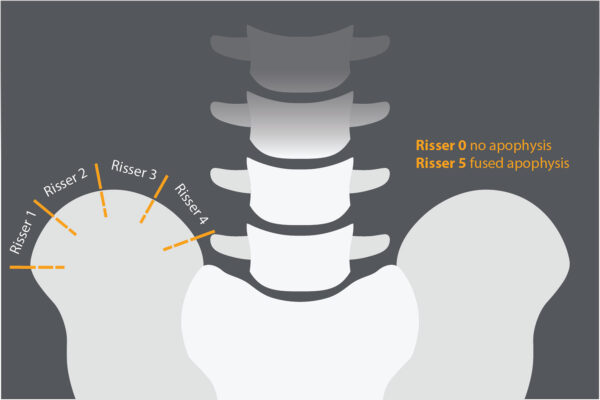Risser Sign In The General Diagnosis Of Scoliosis
When diagnosing scoliosis, specialists use a combination of physical examination and imaging tests (such as MRIs and x-rays).
First, they will evaluate the severity of the curve using the Cobb angle to measure the vertebral rotation. They will then use a degree of curvature chart (a chart that compares the Cobb angle with severity levels) to help assess the condition. If a curve is present and it measures greater than 10 degrees, and there is rotation in the spine a diagnosis of scoliosis is made.
However, when treating the condition, the Cobb angle of the patient’s spine isn’t the only factor to consider. A scoliosis specialist will also use the Risser Sign to form the patient’s overall diagnosis and treatment plan.
What Is The Risser Scale? An Introduction
The Risser scale is a system used to measure the maturity of a patient’s skeleton. More specifically, it measures the ossification of the iliac crest (the top of the pelvic bone) to help indicate how much more growth a patient’s spine will likely have. Ossification refers to the process in which cartilage is turned into bone.
By identifying the stage of ossification, the Risser scale can indicate how much more growth a patient might experience. This information can help a specialist determine whether or not immediate treatment is required and how the treatment plan should be adjusted over time. It can also help a specialist predict how likely it is that scoliosis will develop in a patient that has a mild spinal curve.
What Are The Risser Scale Stages?
The Risser scale stages are determined by looking at X-ray images of the pelvis and assessing how much cartilage growth is present along the iliac crest. The stages range from 0-5, with Risser 0 indicating no ossification of the iliac crest and Risser 5 indicating complete ossification.
Younger patients (generally under ten years old) are likely to be at a Risser 0 stage as their spine is still developing and growing, while patients who have already gone through puberty are likely to be at a Risser 4 or 5 stage as their spine has already finished growing.
There is a sub-scale within the Risser 0 grading of Risser 0- and 0+. Risser 0- is graded when the triradiate cartilage has not yet ossified. Risser 0+ indicates that the triradiate cartilage has ossified.
The patient’s Risser stage can then be used as a guide to estimate how much more growth is left in their skeleton. This is important for scoliosis patients, as it helps determine the best treatment course. Generally speaking, those with a lower Risser stage (0-2) are at a higher risk of scoliosis progression, so specialists may need to initiate a more-involved treatment plan.
On the other hand, patients with a higher Risser stage (3-5) can typically be monitored over time, as there is less risk of scoliosis progression. Of course, the severity of the curve also plays a vital role in treatment, and the scoliosis specialist will consider all of these factors before developing a treatment plan.

Risser scale progression
With all of that in mind, the following is a brief breakdown of each stage of the Risser scale:
- Risser 0-: There has been no ossification of the iliac crest yet and the triradiate cartilage is open.
- Risser 0+: There is no ossification of the iliac crest and the triradiate cartilage is closed.
- Risser 1: Under 25 percent of the iliac crest has ossified. Patients at this stage tend to be at the beginning of puberty.
- Risser 2: Between 25 and 50 percent of the iliac crest has ossified.
- Risser 3: Between 50 and 75 percent of the iliac crest has ossified. Patients at this stage are usually in the middle of puberty.
- Risser 4: Over 75 percent of the iliac crest has ossified.
- Risser 5: The iliac crest is fully ossified. Patients at this stage are typically full-grown adults.
How Is The Risser Scale Used In Diagnosing And Treating Scoliosis?
By looking at the stage of ossification of the iliac crest, specialists can estimate how much more growth is left in the patient’s spine. Patients who are still growing (Risser 0-2) are at a higher risk of scoliosis progression and should be monitored more closely.
Those who have already reached full maturity (Risser 4-5) are less likely to experience further progression and may be able to wait before initiating a treatment plan, depending on the severity of their spinal curvature and the symptoms that they are experiencing.
Using Risser To Evaluate Factors That Develop Scoliosis
The Risser scale helps scoliosis specialists evaluate multiple factors that can contribute to the development of scoliosis. For example, since the Risser scale assesses the maturity of a patient’s skeleton, it can be used to gauge if growth spurts may have caused scoliosis.
Additionally, the Risser scale can help determine how much more growth may be left in the patient’s spine and if that could potentially cause the spinal curve to worsen.
Using Risser To Monitor Scoliosis Treatment Progress
The Risser scale can also be used to gauge the effectiveness of scoliosis treatments. In many cases, non-surgical treatment methods such as bracing and physical therapy may be used to help control the progression of the spinal curve.
For example, if the Cobb angle of the spine is no longer increasing and the patient’s Risser stage shows that they have achieved full skeletal maturity, this could indicate that the treatment has been effective at stopping progression.
What Can Influence The Risser Score?
The ossification of the iliac crest occurs at a different rate for everybody. For example, girls tend to experience puberty and a corresponding growth spurt earlier than boys, so their iliac crest ossification will usually be further along. Additionally, some people’s bones may mature faster than others, which can lead to a higher Risser score.
Genetics can also play a role in the ossification of the iliac crest. Certain genetic conditions can cause bones to mature faster or slower than usual. As such, specialists must evaluate a patient’s Risser score when assessing their scoliosis, as it can provide valuable information regarding the maturity of their bones and how much more growth they may experience.
What Are The Key Considerations When Using Risser?
When using the Risser scale, it’s important to remember that it doesn’t always accurately reflect a patient’s skeletal maturity. There are other factors that can influence the ossification of a patient’s iliac crest, including genetics and lifestyle choices.
While the Risser score can be beneficial, other vital considerations must also be taken into account when evaluating a patient’s scoliosis, including:
- Patient Age: The Risser sign estimates the maturity of a patient’s bones, so age should be considered when assessing the Risser score.
- Curvature Severity: The severity of a patient’s spinal curvature should also be considered when interpreting the Risser sign. Two curves measuring at the same Cobb angle may progress at different rates based on the Risser score.
- Overall Health Status: It is essential to evaluate a patient’s overall health status when assessing the Risser sign as this can impact treatment options. For example, patients with certain medical conditions, such as those affecting bone density, may not respond as well to certain treatments.
- Other Conditions: Any other conditions that may be influencing the patient’s scoliosis should also be considered when assessing the Risser sign. For example, Marfan’s syndrome or Ehler-Danlos Syndrome may cause scoliosis and should be considered in addition to the Risser score.
The Risser sign is a reliable method for assessing the maturity of a patient’s bones and determining if there may be further growth in their spine. It’s also helpful in monitoring the progression of scoliosis and gauging the effectiveness of treatment methods.
However, it is essential to note that the Risser sign does not measure spinal curvature or progression directly. Instead, it is used to indicate bone maturity, which can help inform treatment decisions.
What Are The Recommended Treatments For Scoliosis Based On Risser?
The Risser scale helps determine an effective treatment plan; however, Risser scores must be considered in conjunction with other factors, including the Cobb angle of the spine. For example, a child at a Risser 0 stage with a slightly moderate scoliosis curve (as defined by the Cobb angle measurement) is more at risk of significant progression.
In such a case, a brace might be recommended. However, someone with the same curve at a Risser 5 may not be prescribed a brace right away. Because their spine is already fully formed, their curve isn’t likely to progress nearly as fast, and a more conservative treatment plan may be recommended.
Get A Risser Assessment For Your Scoliosis
When it comes to diagnosing and treating scoliosis, a reputable scoliosis specialist will make a risk of progression assessment by taking into account the size of the curvature and the Risser sign via an X-ray evaluation. An experienced specialist can interpret the results and make recommendations based on the patient’s specific needs and goals.
At Square ONE Health, our scoliosis specialists provide comprehensive assessments, including Risser sign evaluations and curve size measurements, to determine the best treatment solution for each patient. In addition, we prescribe scoliosis rehabilitation, bracing, and exercise using several proven treatment modalities.
The methods include the Schroth Method, the Scientific Exercise Approach to Scoliosis (SEAS) method, and Chiropractic Biophysics (CBP), as well as bracing to help manage scoliosis and improve spinal health. Call our office today for more information about how we tailor our scoliosis treatment plans to meet each patient’s individual diagnosis.
At Square One Health, we will help you discover the path to a better quality of life. Schedule your consultation today!
